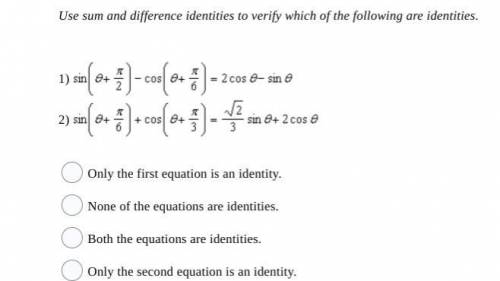Use sum and difference identities to verify which of the following are identities.
1) <...

Mathematics, 31.03.2020 22:04 alisonlebron15
Use sum and difference identities to verify which of the following are identities.
1)
2)
Question 2 options:
Only the first equation is an identity.
None of the equations are identities.
Both the equations are identities.
Only the second equation is an identity.


Answers: 1


Other questions on the subject: Mathematics


Mathematics, 21.06.2019 13:30, sarahlearn3
Write the converse of the following statement: if the trees have no leaves, then it is fall. if the trees have no leaves, then it is fall. the trees have no leaves, therefore it is fall. it is fall since the trees have no leaves. if it is fall, then the trees have no leaves.
Answers: 2

Mathematics, 21.06.2019 21:50, roxanneee2145
5. which description does not guarantee that a quadrilateral is a squar ajo is a parallelogram with perpendicular diagonals 0% has all sides congruent and all angles congruent o has all right angles and has all sides congruent 10% is both a rectangle and a rhombus 30%
Answers: 2
You know the right answer?
Questions in other subjects:













